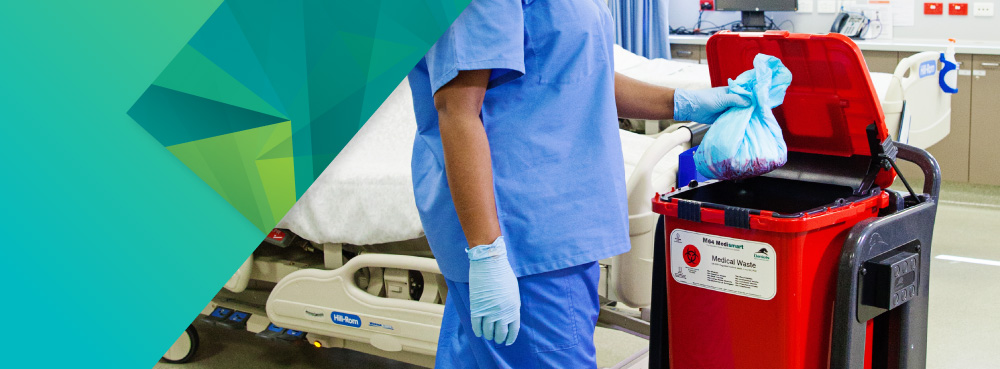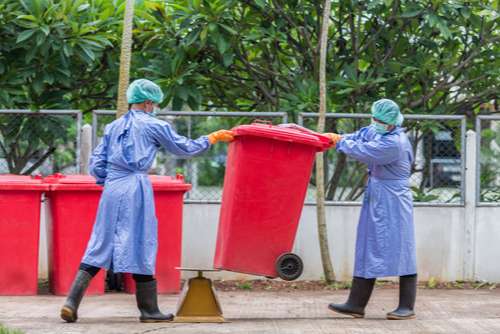Medical Waste Removal Proficiency: Where Service Quality Satisfies Health Specifications
Medical Waste Removal Proficiency: Where Service Quality Satisfies Health Specifications
Blog Article
Minimize Costs and Make Best Use Of Safety: Effective Medical Garbage Disposal Techniques
Efficient medical waste disposal techniques are crucial for health care centers to lessen costs and optimize safety. By implementing proper partition and categorization, reliable packaging and labeling, safe transportation and handling, effective treatment and disposal approaches, and compliance with regulative guidelines, healthcare centers can ensure the safe and accountable management of medical waste.

Appropriate Partition and Categorization
Appropriate segregation and categorization are critical elements of reliable clinical waste disposal strategies, making sure the safety and security of health care workers, the general public, and the environment - medical waste removal near me. medical waste disposal services with WasteX. By separating different sorts of clinical waste at the point of generation, healthcare centers can reduce the threat of cross-contamination and prospective injury to people and ecological communities
Among the key consider appropriate partition is the identification and classification of medical waste. This entails categorizing waste right into various teams, such as infectious, harmful, radioactive, or pharmaceutical waste. Each group calls for details handling, storage, and disposal methods to stop any kind of negative results on human health and the setting.
Furthermore, proper segregation additionally includes the usage of color-coded tags and containers to plainly recognize and set apart the numerous types of clinical waste. This assists healthcare workers and waste management personnel to conveniently acknowledge and deal with the waste appropriately. Red containers might be utilized for infectious waste, while yellow containers may be marked for harmful waste.
In enhancement to segregation, proper classification likewise involves the appropriate packaging and control of medical waste. This ensures that waste is safely saved and transferred without posing any type of threats to people or the setting. Utilizing puncture-resistant and watertight containers, in addition to properly securing and labeling them, aids to stop any type of unexpected direct exposure or release of dangerous substances.
Effective Packaging and Classifying
Reliable product packaging and labeling play a vital role in making sure the safe and effective disposal of clinical waste. Proper packaging is vital to avoid leak, damage, or splilling throughout transportation and handling. It aids to minimize the risk of contamination and safeguards health care employees, waste monitoring workers, and the environment from potential risks.
Clinical waste must be packaged in tough and watertight containers that are immune to penetrate and breakage. These containers need to be effectively sealed to prevent any kind of leakage. Furthermore, the packaging must be able to stand up to the conditions of transport, consisting of temperature variations and misuse.
Classifying is equally essential as it supplies crucial info concerning the contents of the waste and any potential hazards related to it. The labels should include the name of the healthcare center, the sort of waste, and any type of unique handling directions. Standard and clear labeling guarantees that waste monitoring personnel can quickly determine and deal with the waste appropriately.
Reliable product packaging and labeling also help in the correct partition and classification of clinical waste. Clear labeling enables for very easy identification of various waste streams, such as infectious waste, sharps, or pharmaceutical waste. This aids in enhancing the disposal process and ensuring that the waste is dealt with or dealt with based on regulative guidelines.
Safe Transportation and Handling
Making sure the risk-free transport and handling of clinical waste is of utmost importance in order to protect against any kind of prospective health and ecological risks. Medical waste, such as sharps, infected products, and pharmaceutical waste, should be properly packaged and managed to minimize the risk of direct exposure to harmful substances and pathogens.
Transporting clinical waste needs conformity with rigorous guidelines and standards established by environmental agencies and neighborhood authorities. These policies intend to shield the health and safety and security of workers associated with waste administration and prevent the more release of unsafe materials right into the atmosphere.
To guarantee safe transportation, clinical waste ought to be placed in leak-proof and puncture-resistant containers that are effectively sealed and labeled. These containers should be secured in a manner that protects against spills or breakage throughout transit (medical waste removal services). Furthermore, it is critical to utilize specific lorries furnished with proper safety features to move clinical waste. These vehicles should have sufficient air flow and be made to stop leak or contamination.
Handling medical waste likewise calls for proper training and adherence to safety and security procedures. Workers entailed in the handling of clinical waste should use appropriate individual protective tools (PPE) such as masks, gowns, and handwear covers to minimize the risk of direct exposure. They need to additionally adhere to stringent hygiene practices to stop the spread of infections and guarantee the risk-free disposal of waste.
Reliable Therapy and Disposal Methods
Carrying out suitable treatment and disposal techniques is essential in taking care of clinical waste properly and lessening potential health and environmental dangers. Clinical waste, that includes sharps, infectious materials, chemicals, and drugs, can present considerable risks otherwise handled and disposed of properly. There are several therapy and disposal techniques offered that stick to regulative guidelines and promote secure techniques.
One usual method is incineration, which entails burning the waste at heats. Incineration is efficient in ruining virus and minimizing the volume of waste, but it can release hazardous contaminants into the air otherwise correctly managed. For that reason, it is necessary to use modern-day incinerators furnished with discharge control modern technologies.
Another approach is autoclaving, which utilizes heavy steam and Learn More stress to sanitize the waste. Autoclaving works in killing virus and reducing the volume of waste, however it requires cautious monitoring and maintenance to make sure appropriate functioning. The decontaminated waste can after that be securely disposed of in a landfill.
Chemical therapy is one more alternative, which includes utilizing disinfectants or other chemicals to neutralize pathogens. This technique is frequently used for fluid waste, such as research laboratory specimens. Nevertheless, it is essential to use appropriate chemicals and adhere to appropriate treatments to ensure reliable treatment and stop environmental contamination.

Conformity With Regulatory Guidelines
Following governing standards is necessary in guaranteeing proper compliance with clinical waste disposal practices. These guidelines are put in area to safeguard public health and wellness, stop ecological contamination, and preserve work environment safety and security. Conformity with regulatory standards is vital for healthcare facilities, as non-compliance can result in fines, fines, and reputational damage.
Governing guidelines lay out the proper handling, storage, transport, and disposal of clinical waste. These standards likewise address the partition of various waste streams, such as sharps, transmittable waste, and pharmaceutical waste.
To preserve compliance, medical care facilities should develop extensive waste management programs that include personnel training, routine audits, and ongoing surveillance. It is crucial to keep updated with any changes or updates to regulative guidelines, as practices may develop over time. By staying informed and carrying out proper protocols, health care facilities can reduce the capacity for regulative violations and shield the health and wellness and security of their team, people, and the surrounding area.
Verdict
In conclusion, applying reliable clinical garbage disposal methods is vital for decreasing expenses and optimizing security. Appropriate segregation and categorization, reliable packaging and labeling, safe transport and handling, and effective therapy and disposal techniques are essential steps to make certain compliance with regulatory standards. medical waste removal services. By adhering to these techniques, medical care facilities can protect the setting and public health and wellness while additionally lowering monetary problems related to clinical waste monitoring
By implementing proper partition and classification, efficient packaging and labeling, secure transport and handling, efficient treatment and disposal methods, and conformity with regulative standards, medical care facilities can make certain the responsible and safe monitoring of clinical waste. Red containers may be utilized for contagious waste, while yellow containers may be designated for unsafe waste.
Standard and clear labeling makes sure that waste management employees can quickly recognize and manage the waste appropriately. (medical waste disposal services with WasteX)
Clear labeling permits for simple identification of various waste streams, such as contagious have a peek here waste, sharps, or pharmaceutical waste. These guidelines likewise address the partition of different waste streams, such as sharps, contagious waste, and pharmaceutical waste.
Report this page